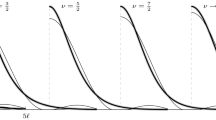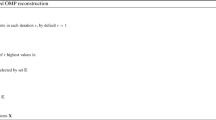Abstract
We address the problem of blind separation of a static, linear orthogonal mixture, where separation is not based on statistical assumptions (such as independence), but on the sources’ spatial sparsity. An algorithm for this problem was proposed by Mishali and Eldar in 2008. It consists of first recovering the supports of the sources, and then recovering their values, but has two shortcomings: One is an assumption that the spatial sparsity level at each time-instant is constant and known; The second is the algorithm’s sensitivity to possible presence of temporal “blocks” of the signals, sharing identical supports. In this work we propose two pre-processing stages for improving the algorithm’s applicability and the performance. A first stage is aimed at identifying “blocks” of similar support, and pruning the data accordingly. A second stage is aimed at recovering the sparsity level at each time-instant. We demonstrate the improvement using both synthetic data and mixed text-images. We also show that the improved algorithm outperforms the recovery rate of alternative source separation methods for such contexts, including K-SVD, a leading method for dictionary learning.









Similar content being viewed by others
References
Mishali, M., & Eldar, Y.C. (2009). Sparse source separation from orthogonal mixtures, In IEEE International Conference on Acoustics, Speech and Signal Processing (ICASSP 2009), 3145–3148.
Abrudan, T.E., Eriksson, J., Koivunen, V. (2008). Steepest descent algorithms for optimization under unitary matrix constraint. IEEE Transactions Signal Process, 56(3), 1134– 1147.
Georgiev, P., Theis, F., Cichocki, A. (2004). Blind source separation and sparse component analysis of overcomplete mixtures, In ICASSP, (Vol. 5).
Gribonval, R., & Lesage, S. (2006). A survey of sparse component analysis for blind source separation: Principles, perspectives, and new challenges. In Proceedings of ESANN (Vol. 6, pp. 323–330).
Bofill, P., & Zibulevsky, M. (2001). Underdetermined blind source separation using sparse representations. Signal Processing, 1(1), 2353–2362.
Li, Y., Cichocki, A., Amari, S. (2004). Analysis of sparse representation and blind source separation. Neural Computation, 16(6), 1193–1234.
Aharon, M., Elad, M., Bruckstein, A.M. (2006). On the uniqueness of overcomplete dictionaries, and a practical way to retrieve them. Linear Algebra and Its Applications, 416(1), 48– 67.
Mishali, M., & Eldar, Y.C. (2008). Sparse source separation from orthogonal mixtures, CCIT Report no.704, EE Department Techion Israel Institute of Technology.
Cardoso, J.-F., & Souloumiac, A. (1993). Blind beamforming for non Gaussian signals. IEEE Proceedings-F, 140(6), 362– 370.
Hyvärinen, A. (1999). Fast and robust fixed-point algorithms for independent component analysis. IEEE Transactions on Neural Networks, 10(3), 626–634.
Chris Ding, T.L., & Jordan, M.I. (2010). Convex and semi-nonnegative matrix factorizations. IEEE Transactions on Pattern Analysis and Machine Intelligence, 32(1), 45– 55.
Plumbley, M.D. (2003). Algorithms for nonnegative independent component analysis. IEEE Transactions on Neural Networks, 14(1), 534–543.
Author information
Authors and Affiliations
Corresponding author
Rights and permissions
About this article
Cite this article
Lindenbaum, O., Yeredor, A., Vitek, R. et al. Blind Separation of Orthogonal Mixtures of Spatially-Sparse Sources with Unknown Sparsity Levels and with Temporal Blocks. J Sign Process Syst 79, 167–178 (2015). https://doi.org/10.1007/s11265-014-0918-8
Received:
Revised:
Accepted:
Published:
Issue Date:
DOI: https://doi.org/10.1007/s11265-014-0918-8




